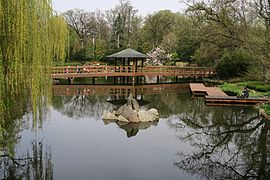Japanese garden (Wroclaw)
The Japanese Garden ( Polish: Ogród Japoński ) in Wroclaw is located within the Scheitniger Park (today Park Szczytnicki ). It was laid out in 1913 in the style of a Japanese convertible garden.
history
As part of the celebrations in Wroclaw, in 1913 to commemorate the Prussian wars of liberation should I be held against Napoleon, was adjacent to the site of the Centennial Hall also planned a Japanese garden. After the Japanese woodcut had already aroused interest in Japanese culture, it was Lafcadio Hearn's works , which were available in German translation from 1904 and led to an in-depth study of the country. The Japanese connoisseur and admirer, Count Friedrich von Hochberg (1868–1921), was commissioned with the concept of the garden, which was to be created at the same time as the Japanese garden in Leverkusen . He and his gardener J. Anlauf were supported by the Japanese gardener Arai Mankichi. Since the pond plants needed warm water, a boiler was installed in the northern part of the garden, which heated the water in part of the pond to 24 degrees. The garden became one of the greatest attractions of the exhibition of the century.
After the show, many of the elements that had been loaned for the duration of the exhibition of the century, which determined the Japanese character of the garden, were returned. Several buildings that were of a temporary nature were also demolished. However, the footpaths, the shape of the pond and the southern part of the garden with its hilly landscape, the water sources and the flora have been preserved.
In 1996, the restoration work began with the participation of professionals (gardeners, architects, stone architects, garden architects, etc.) from the city of Nagoya . What was left of the system from 1913 was expanded with many new components. In 1997 the garden was opened under the Japanese name "Hakkō-en" (白 紅 園), in German "White-Red Garden", alluding to the national colors of Poland and Japan. Shortly after the opening, the garden was hit by the Oder floods, with particularly severe damage to the flowering plants. The restoration took almost a year.
The attachment
The garden was given two gates: the main gate is covered in the Sukiya style (数 寄 屋 造 り, sukiya-zukuri), the simple side gate in the Kabuki style (冠 木造 り, kabuki-zukuri). The former cascade has been converted into a "male" cascade with a rapidly and heavily falling water curtain. In addition, a second, “female”, slowly flowing cascade with two fall levels was set up.
The water from the two cascades flows into a pond with varied bank areas. Around this pond, the garden is laid out in the form of a Japanese convertible garden, although the water surface is not enclosed here, but is open to the southeast and continues outside the garden. The pond is crossed by two bridges within the garden. The middle bridge is covered and has an extension in the middle in the form of a hexagonal pavilion. It is in contrast to the smaller drum bridge (太鼓橋, taikobashi) a very modern construction, has with its name "Dream Pavilion" (夢殿, Yumedono) on the hexagonal pavilion in the temple Hōryū-ji of Prince Shōtoku back to the 7th century.
The bank areas are varied: in the north we find a row of flat stones in the water, over which one can walk parallel to the bank. They are called Sawatari (沢 渡 り). On the small, elongated island in the north there is a trimmed tree and a small three-story stone pagoda (三重 塔, sanjū-no-tō). A rectangular stone slab protruding into the pond symbolizes a landing place (船 着 場, funatsukiba). Further south there is a stone lantern from the 19th century, which is called the "drum lantern" (太 鼓 燈籠, Taiko tōrō) because of its slightly arched column. It is a gift from the Japanese for the reconstruction of the garden. - In the southern part of the garden there is a stone lantern in the Kasuga style (春日 造 り) in front of the tea house “Azumaya” (東 屋) in Sukiya style.
The garden is rich in trees and bushes. In addition to 200-year-old oaks, the flowering plants mainly include rhododendrons and azaleas. Among the thirty plants in Japan are mainly individual gold larch , the Ginkgo -Trees, Japanese lavender Gentiles and Japanese string trees to mention.
- There is a small entrance fee (2017: four złoty) to visit the garden.
photos
literature
- Leaflets of the garden (German, English)
- Chudzyński, Lesław u. a .: Ogród Japoński we Wrocławiu . Oficyna Wydowbucta, 2016. ISBN 978-83-7977-045-8 .
- Jerzy Ilkosz, Beate Störtkuhl (translator): The Centennial Hall and the exhibition grounds in Breslau - the work of Max Berg . Oldenbourg Wissenschaftsverlag 2006. ISBN 978-3-486-57986-4 .
Coordinates: 51 ° 6 ′ 36 ″ N , 17 ° 4 ′ 46 ″ E








